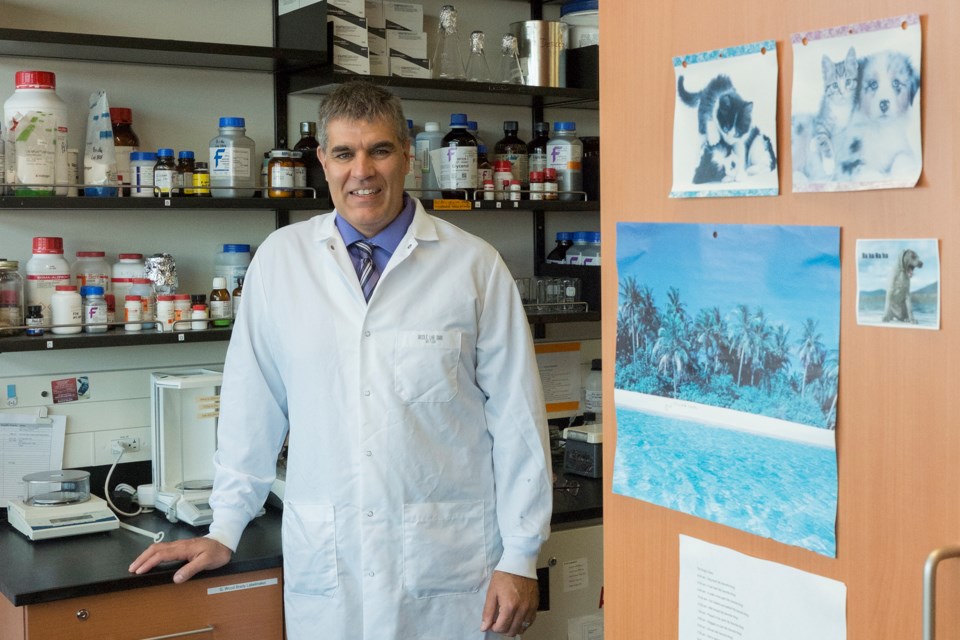The type of bone cancer which led to the amputation of Terry Fox's leg may be relatively rare in humans, but is 10 times as likely to occur in dogs — sparking an innovative cancer research at University of Guelph and a renewal in funding from the foundation that was made in honour of the man who died over 35 years ago, partway through his Marathon of Hope.
Dr. Byram Bridle, professor in the university’s Department of Pathobiology, said most biomedical research is done by determining a successful treatment in a pre-clinical phase using mice or rats and then taking a ‘gigantic leap’ by applying that treatment to humans.
If you find a treatment that works on one mouse, said Bridle, it will often work on other laboratory mice because they are genetically identical and exposed to the same environment, but most human clinical trials fail to work or even receive Health Canada approval.
“With human clinical trials, what we are trying to offer patients is hope for new or better treatments. The problem is, in the field of cancer research, the statistics are abysmal. When trying to jump from mice to humans, more than 95 per cent of the human clinical trails fail,” said Bridle.
Instead, Bridle and his team have partnered with the Ontario Veterinary College’s Animal Cancer Centre, which is located on the U of G campus, to apply their research that has been conducted on rodents to larger mammals — cats and especially dogs.
Dogs are 10 times more likely than humans to develop osteosarcoma, a bone cancer that mostly occurs in humans during childhood and adolescence and is the kind of cancer which led to the amputation of Terry Fox’s right leg.
"So when you think his scenario, it was identified, the cancer was found in the bone of his leg and that leg had to be amputated. The exact same thing happens in the dogs. The dogs come, the cancer is found as a painful lump in one of the bones of one of the four legs and the leg will be amputated — exactly like with Terry Fox," said Bridle.
In the case of bone cancer, almost all patients who die end up with cancer migrating to their lungs, as was the case with Fox.
"He had to end his Marathon of Hope just outside of Thunder Bay and it was with lung issues. The cancer cells had migrated to his lungs and he had all kinds of lung tumours that developed and ultimately what killed him. Ninety per cent of the dogs that succumb to the bone cancers, it's exactly the same, it's because of the cancer growing in the lungs," said Bridle.
The University of Guelph is a member of the Canadian Oncolytic Virus Consortium, who recently received a five-year, $17.5 million funding commitment for their research by the Terry Fox Foundation.
Because Bridle and his team work within the national consortium, he said it allows for broader collaboration and sharing of ideas.
"We took a pre-clinical therapy that we developed, we published that finding in 2010 and five years later in 2015 through this network, a clinical trial was actually started. So we have already established a track record to go from pre-clinical development to human clinical trial,” said Bridle.
Clinical trials for animals are also much more cost-effective than for humans, said Bridle. Trials can be conducted on about 10 dogs for the same cost doing one human trial.
“The idea is a veterinary clinical trial is going to be less expensive and it’s going to be faster, so we can test these things for less money and quicker than a clinical human trial,” said Bridle.
At University of Guelph, testing on cats and dogs is as far as the team could take their research.
"Working on my own in my lab here, there's no way I could envision actually going into human clinical trials. I could develop ideas here and take them so far, but it's always a case of getting other people interested who have the ability and expertise to actually do the testing in human patients," said Bridle.
“It is through this network funded by the Terry Fox foundation that will allow us to go into the human trials,” he added.
Currently, Bridle and his team are working on using vaccines to effectively reintroduce a patient’s own cancer cells wrapped with an oncolytic virus, which is intended to infect and kills cancer cells in the body.
"What we envision in the future is every patient will be treated with their own cancer cells, so it would be tailored to their unique cancer," said Bridle.
Using a patient’s own immune system to fight cancer is a completely different approach than the standard radiation and chemotherapy, he said.
“Chemotherapy and radiation therapy that we use is very poisonous. The idea was we are trying to poison and kill cancer cells without killing off the patient,” said Bridle.
“Our immune systems naturally want to get rid of something that is dangerous to the human body. So if we get an infection, a virus or bacteria our immune systems are designed to clear those things,” he adds.
In recent preclinical trials involving mice, 100 per cent of the rodents with micro metastases who were treated with one of these vaccines were cured and 50 per cent of mice with larger macro metastases were also cured.
"We have an extremely promising therapy. Now we are in the process of trying to optimize it and get it ready to move into dogs in the relatively near future — but that is undefined at this point," said Bridle.
If successful in dogs, human trials would likely still be years away, said Bridle.
